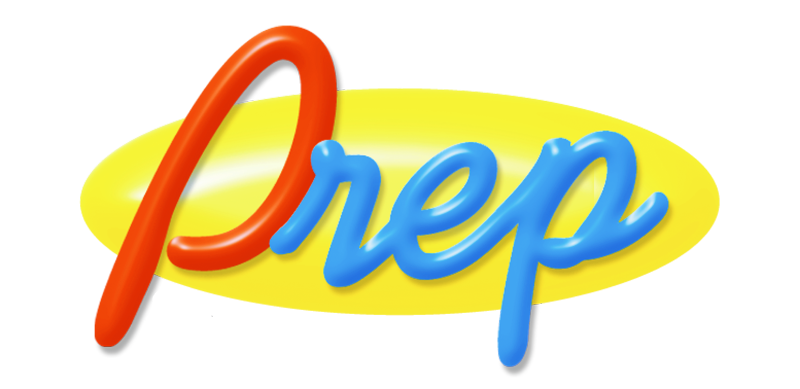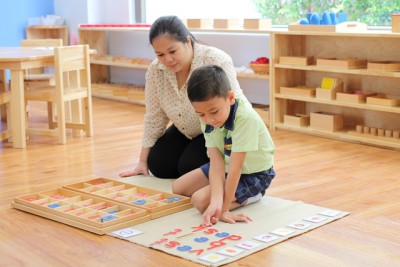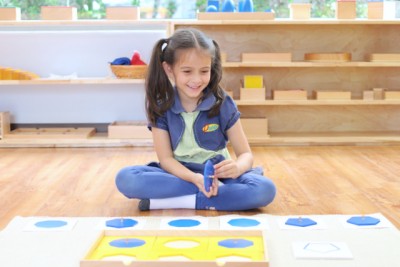 Some of the characteristics that distinguish the Prep International School
Some of the characteristics that distinguish the Prep International School
Montessori program are:
Inner guidance of nature : All children have inherent inner directives from nature that guides their true normal development.
Planes of development : The first plane (ages 0–6) involves basic personality formation and learning through physical senses. Children experience sensitive periods for acquiring language and developing basic mental order.
Observation and indirect teaching : The teacher’s role is to observe children engaged in activities that follow their own natural interests. This indirect teaching is to control the environment, not the child. For example; a Montessori Method class has the teacher resolving misbehavior by refocusing the child to some positive activity, rather than engaging in the ordinary system of rewards and punishments.
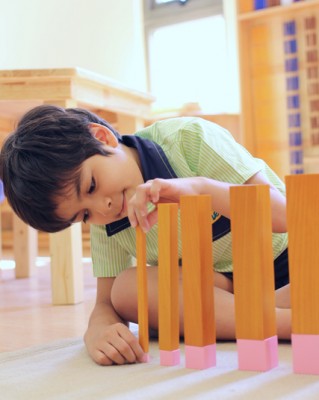 Normalization : During the 0–6 plane of development, children have the ability to shift their fundamental being from the ordinary condition of disorder, inattention and attachment to fantasy to a state of perfect normal being. Showing such external behavior as spontaneous self discipline, independence, love of order, complete harmony and peace with others in the social situation. This psychological shift to normal being occurs through deep concentration on some physical activity of the child’s own free choice.
Normalization : During the 0–6 plane of development, children have the ability to shift their fundamental being from the ordinary condition of disorder, inattention and attachment to fantasy to a state of perfect normal being. Showing such external behavior as spontaneous self discipline, independence, love of order, complete harmony and peace with others in the social situation. This psychological shift to normal being occurs through deep concentration on some physical activity of the child’s own free choice.
Absorbent mind : The young child (0–6) has an absorbent mind which naturally incorporates experiences in the environment directly into its whole basic character and personality for life.
Individualized Instruction : Each child learns and develops at her/his own pace through the use of materials and lessons introduced by our trained staff. The integrated curriculum is introduced sequentially and at the developmental level of each individual child, allowing every child to work to capacity and at their ability level.
Child Directed Program : Within the structure of the classroom and curriculum, children are encouraged to pursue their interests, make responsible choices for themselves and direct themselves to constructive activities. Since each child’s interests vary, this opportunity results in an independent and self-motivated learner.
Freedom for self-directed learning : The Montessori Method respects the children’s freedom to choose their own activities. This freedom allows children to follow their inner guidance for self-directed learning.
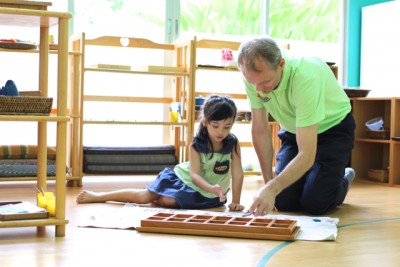 Designed Environment/Materials : The school’s environment is prepared with a variety of specially designed Montessori materials like multi-sensory, sequential and self correcting. Educational materials are carefully selected to meet the needs of a range of students in each class and to meet the goals of each program.
Designed Environment/Materials : The school’s environment is prepared with a variety of specially designed Montessori materials like multi-sensory, sequential and self correcting. Educational materials are carefully selected to meet the needs of a range of students in each class and to meet the goals of each program.
Prepared environment : The right precise conditions around children allow for and support their true natural development. For young children, the environment must be prepared in this way by providing a range of physical objects that are organized and made available for free, independent use, to stimulate their natural instincts and interests for self-directed learning.
Specialized Staff : In addition to background and experience in early childhood education, our teachers receive specialized training in the Montessori Method. Training programs throughout the world prepare and certify teachers in this specialized field of education. The course of study includes educational philosophy, academic training in the curriculum areas, early childhood development, classroom management and use of materials for individual lessons.
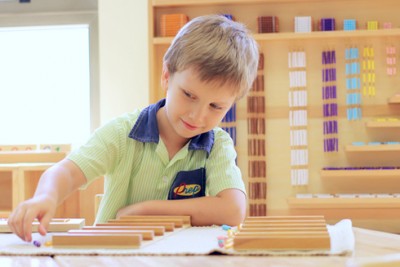 Hands-on Approach to Learning : The use of materials for learning in the Montessori classroom is an integral part of the program from pre-school through the elementary years. Based on a belief that children learn by doing, lessons for math, language and all subject areas include hands-on materials for use by our students.
Hands-on Approach to Learning : The use of materials for learning in the Montessori classroom is an integral part of the program from pre-school through the elementary years. Based on a belief that children learn by doing, lessons for math, language and all subject areas include hands-on materials for use by our students.
Integrated Curriculum : The curriculum integrates many subject areas into the lesson at hand. This enables students to use their knowledge and skills in context and to see the “whole” picture and not just fragments.
Learning Areas are as follows:
Practical Life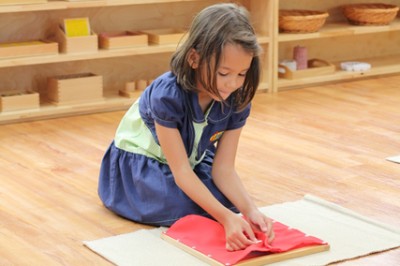
To prepare your child to gain control in the coordination of his/her movements, help your child to gain independence and adapt to his/her social society.
Sensorial Exploration
The world is color, size, dimension, shape, form, sound, touch, taste, and smell. In order to continue her creative task of development, a child needs to satisfy and express the impressions she has already received. The Sensorial Montessori materials use the child’s senses to clarify, classify, and comprehend the world. The Sensorial materials are specifically designed to teach multi-sensually and to educate the senses.
By appealing directly to the young child’s active sensory antennae, learning is a natural result of the child’s desire to explore
Mathematics
The Mathematics area also introduces abstract ideas and relationships through the use and manipulation of concrete materials. For example, through the materials a child can physically see and feel that “1” is smaller than “1000”. The concept of “10” is emphasized in many materials, as our whole number system is based on this. The child is introduced to the functions and operations of numbers, learning addition and subtraction, all through the use of the unique Montessori materials.
In the first plane of development (0–6 years of age), the Montessori language materials provide experiences to develop use of a writing instrument and the basic skills of reading a written language. For writing skill development, the use of metal insets provide essential exercises to guide your child’s hand in following different outline shapes while using a pencil. For reading, a set of individual letters, commonly known as sandpaper letters, provide the basic means for associating the individual letter symbols with their corresponding phonetic sounds. Displaying several letters, a lesson known as the “Seguin three-period lesson” guides your children to learn the letter sounds and the movements of their shapes. When your child is proficient with the majority of the sounds, he or she can create words using moveable letters from the “moveable alphabet”. When their hand is strong enough from use with the Metal Insets and other materials, he/she may write words with a pencil using the shapes he/she learned from the sandpaper letters. Following writing with the movable alphabet, your child begins to read words. Montessori language materials have also been developed to help children learn grammar, including parts of speech such as nouns, verbs, adjectives, articles, prepositions, adverbs, conjunctions, pronouns and interjections. The materials evolve for further complexity in the later planes of development.
Cultural Subjects (which include Geography, History, Natural Sciences, Experimental Sciences)
The work of classification and language are extended in the Cultural area. Materials are available to enable scientific exploration of biology, geography, history, physical along with earth science.
